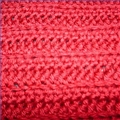At first glance, a rose looks like a complex crochet pattern, but it's very simply. Most beginners can crochet their first rose within minutes. There are only 3 steps:
1. Crochet a chain stitch
2. Crochet once back across the chain
3. Wind the rose into shape and sew through the base with a yarn needle.
You can use crocheted roses to embellish hats, scarves, headbands, and many other handmade projects.
1. Crochet a chain stitch
2. Crochet once back across the chain
3. Wind the rose into shape and sew through the base with a yarn needle.
You can use crocheted roses to embellish hats, scarves, headbands, and many other handmade projects.
How to Crochet a Rose for Beginners - Step 1
(Unless this is your first project, you probably already know how to crochet a chain stitch. But, for those that are new to crochet, you can find more details here about "How to Chain Stitch.")
Crochet Back Across the Chain
How to Crochet a Rose for Beginners - Step 2
Skip the first chain stitch from the hook. In the second chain stitch from the crochet hook:
Double crochet. Chain 1.
Double crochet. Chain 1.
Double Crochet. Chain 1.
Double Crochet. Chain 1.(You will have 4 double crochets in the second chain stitch from the hook making a "fan" effect.)
Skip the next chain stitch, single crochet 1 time. Chain 1.
(The single crochet draws the end of the double crochet stitches down into a petal form. This is your first rose petal.)
Continue this pattern across the entire length of the chain:
Skip a chain stitch, (double crochet and chain 1) 4 times in the same stitch.
Skip a chain stitch, 1 single crochet. 1 chain.
Form the Rose
How to Crochet a Rose - Step 3
Beginning with the end farthest from the working yarn, roll the petals into a rose shape.
It's best to roll very loosely. I like to pinch the center of the rose tightly to hold it together and then roll the remainder of the crocheted petals as loosely as possible to create an open rose. If you look at the photo at the top one rose was rolled very loosely and the other tightly to compare the finished look.
Thread the working yarn through a yarn needle and use it to stitch the base of the rose in place.























